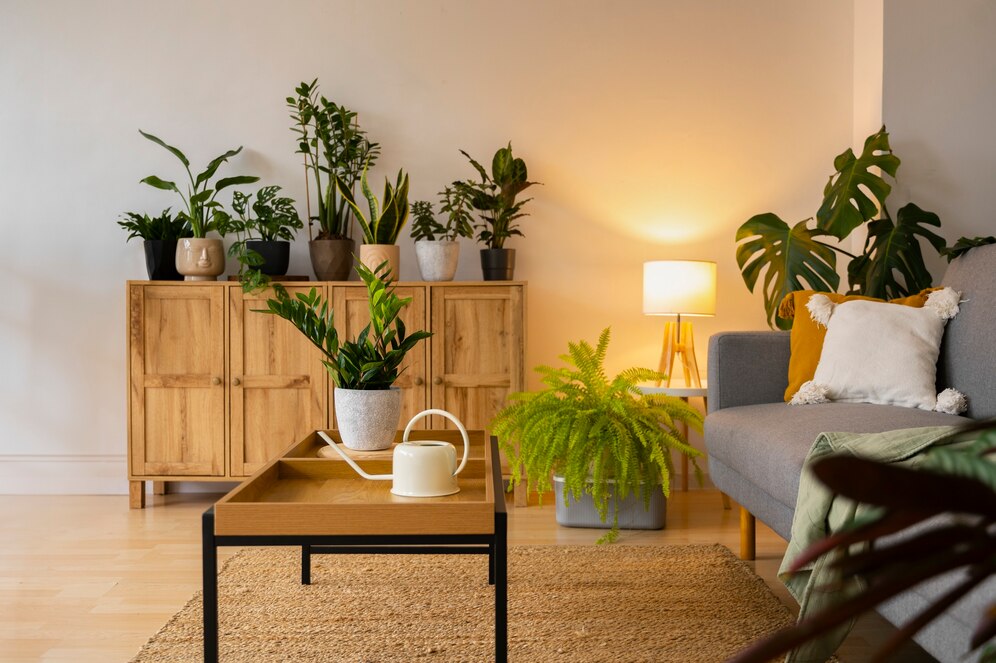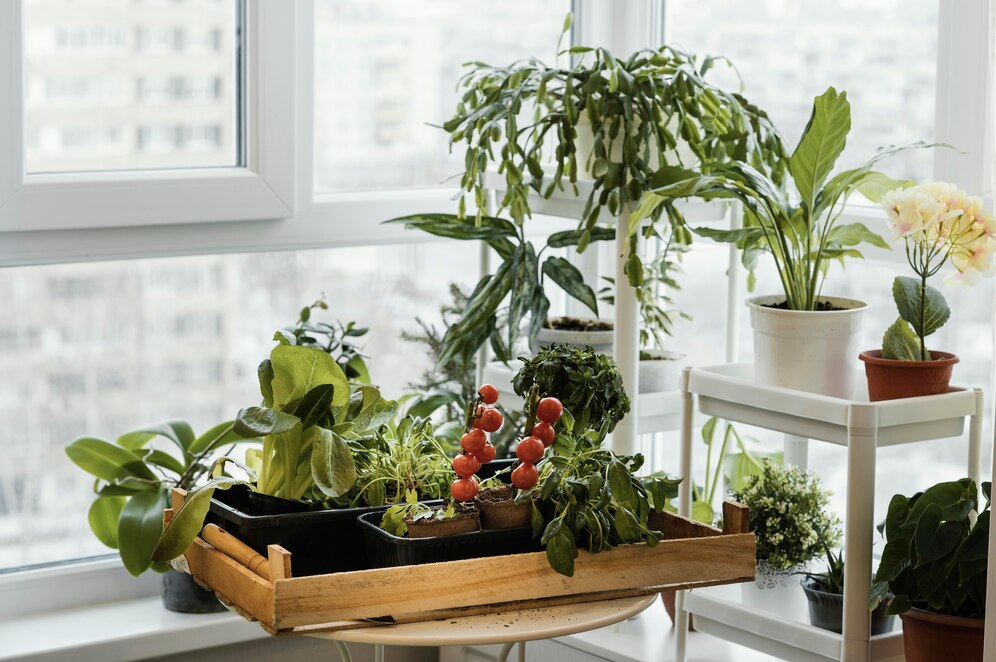
How to Incorporate Greenery into Your Living Space
Adding plants to your home is not just a trend; it’s a lifestyle. It offers many benefits for your living space. Whether you live in a spacious house or a compact apartment, adding greenery can transform your space into a serene oasis. This blog will show why modern indoor plants matter. You’ll learn how to pick the best houseplants for your space. Plus, you’ll find tips for adding greenery to your home. By the end of this article, you’ll be equipped with the knowledge to create a lush, inviting living space that not only looks good but feels good too.
Key Benefits of Adding Greenery to Your Living Space

Why It Matters
Bringing plants into your home isn’t just for looks. It can greatly improve your well-being and the environment around you. Here are some compelling reasons why incorporating plants into your interior design is a wise choice:
- Improved Air Quality: Indoor plants are known for their ability to filter toxins and improve air quality. Spider Plants and Peace Lilies are great at cleaning the air. They remove pollutants like formaldehyde and benzene.
- Better Mental Health: Being around plants helps lower stress, lift your mood, and improve productivity. The presence of greenery has a calming effect, making it easier to relax and focus.
- Aesthetic Appeal: Plants add texture, colour, and life to any room. They can soften hard lines, fill empty corners, and add a touch of nature to modern interiors.
- Higher Humidity: Plants let out moisture into the air through transpiration. This can keep humidity levels just right in your home, especially in dry winter months.
Real-Life Applications
Consider the example of a London apartment where space is at a premium. Placing plants like succulents on windowsills and hanging ferns from the ceiling can turn the apartment into a green retreat. This way, you save valuable floor space. Similarly, in a family home in Manchester, a vertical garden in the kitchen not only serves as a fresh herb source but also as a natural air purifier.
Quick Guide
Your Go-To Greenery Checklist
- Start with easy-care plants like snake plants, spider plants, or peace lilies.
- Use all spaces wisely: think vertical gardens, window sills, and hanging planters.
- Check light and watering needs before placing your plants.
- Group plants for impact and better humidity.
- Avoid overwatering—it’s the number one plant killer!
Pro Tip
When in doubt, group plants in threes. Vary the heights and textures for a layered, natural look—and don’t forget decorative pots to match your interior style.
Important
Plants don’t just decorate a room—they transform how it feels. But to thrive, they need proper placement. Don’t ignore natural light. Even the trendiest plant will struggle in the wrong spot.
Step-by-Step Guide to Incorporating Greenery
Choosing the Right Plants
Modern Indoor Plants
Modern indoor plants are not only stylish but also low-maintenance, making them perfect for busy lifestyles. Some popular choices include:
- Monstera Deliciosa: Known for its unique split leaves, the Monstera is a statement plant that thrives in bright, indirect light.
- Snake Plant (Sansevieria): Ideal for beginners, this plant is nearly indestructible and can tolerate low light and irregular watering.
- Fiddle Leaf Fig: With its large, glossy leaves, this plant adds a touch of elegance to any room. It prefers bright, filtered light and moderate watering.
Best Houseplants for Interiors
When selecting houseplants, consider factors such as light levels, humidity, and your ability to care for them. Here are some of the best houseplants for interiors:
- Peace Lily: Known for its white blooms and air-purifying qualities, the Peace Lily is perfect for low-light areas.
- ZZ Plant (Zamioculcas zamiifolia): This plant is drought-tolerant and thrives in low-light conditions, making it ideal for offices and dimly lit rooms.
- Spider Plant: Easy to grow and propagate, the Spider Plant is great for hanging baskets or as a tabletop plant.
Arranging Your Plants
Adding Greenery to a Home
- Vertical Gardens: These are perfect for small spaces. Use wall-mounted planters or shelving to create a living wall that maximises vertical space.
- Hanging Planters: Ideal for trailing plants like ivy or pothos, hanging planters add visual interest and can be placed in any room.
- Terrariums: These miniature gardens are perfect for desks or coffee tables. They require minimal maintenance and can be customised with a variety of plants and decorative elements.
- Window Sills: Utilise window sills for plants that require more sunlight. Herbs like basil and mint not only thrive here but also provide fresh ingredients for cooking.
Additional Expert Tips & Common Mistakes to Avoid

Expert Tips
- Group Plants Together: Grouping plants can create a microclimate that increases humidity, which is beneficial for the plants.
- Rotate Plants Regularly: To ensure even growth, rotate your plants every few weeks so all sides receive equal light exposure.
- Use Quality Soil: Invest in good potting soil that provides adequate drainage and nutrients to support healthy plant growth.
Common Mistakes to Avoid
- Overwatering: One of the most common mistakes is overwatering, which can lead to root rot. Always check the soil moisture before watering.
- Ignoring Light Requirements: Different plants have different light needs. Ensure you place your plants in suitable locations to avoid stunted growth or leaf drop.
- Neglecting Pest Control: Regularly check plants for signs of pests and treat them promptly to prevent infestations.
Advanced Insights & Expert Recommendations
Advanced Techniques
- Hydroponic Systems: For tech-savvy plant enthusiasts, consider setting up a hydroponic system. This soil-less method of growing plants can be highly efficient and space-saving.
- Smart Plant Care: Use smart sensors to check soil moisture, light, and temperature. They send alerts to your phone when your plants need help.
Expert Recommendations
- Seasonal Rotation: Rotate your plant selection seasonally to keep your space dynamic and interesting. For instance, poinsettias in winter and bright geraniums in summer can add seasonal flair.
- Biophilic Design: Incorporate elements of biophilic design, which focuses on connecting the interior environment with nature. This can include natural materials, textures, and patterns alongside your greenery.
Top 5 FAQs
1. What are the best low-maintenance indoor plants?
Snake plants, ZZ plants, and pothos are top picks. They’re tough, stylish, and don’t mind a bit of neglect.
2. Can I grow plants if my flat has very little light?
Yes! Try low-light champions like peace lilies, ferns, or cast-iron plants. Supplement with grow lights if needed.
3. How do I prevent overwatering?
Use pots with drainage holes and always check if the top inch of soil is dry before watering. Less is more!
4. What’s a good way to add greenery without cluttering my space?
Go vertical. Wall-mounted planters, floating shelves, and hanging baskets save floor space while adding lush visual appeal.
5. Are there plants that help with air purification?
Absolutely. Spider plants, rubber plants, and English ivy all help filter indoor air and bring a breath of fresh air into your home.
Bringing Nature Indoors: A Greener, Healthier Home

Adding plants to your home is a rewarding way to improve its look and feel. By carefully selecting modern indoor plants and the best houseplants for interiors, you can create a vibrant and healthy environment. Remember to consider factors such as light, water, and space when adding greenery to a home. Your living space can be a lush sanctuary. With the right approach, it promotes well-being and sparks creativity. So, why not start today? Embrace the beauty and benefits of nature by bringing the outside in. What plant will you choose to begin your indoor garden journey?